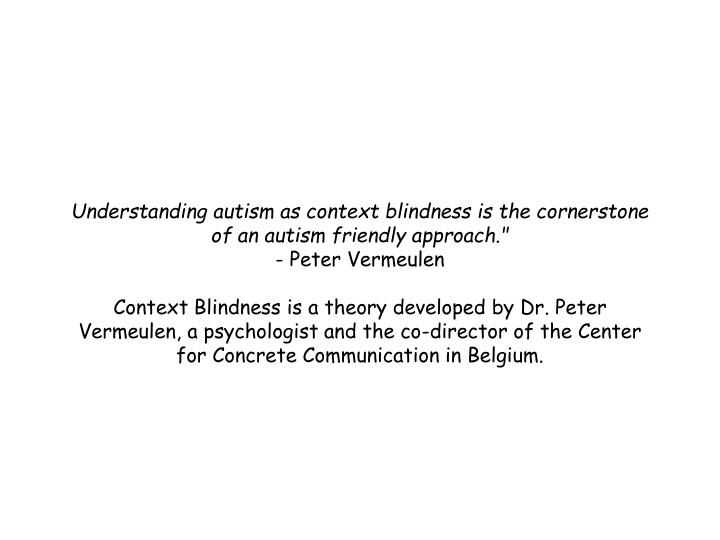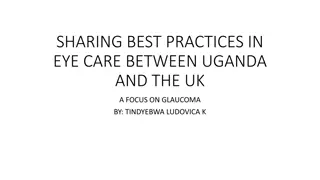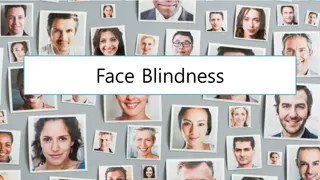
Understanding Autism through Context Blindness - Key Insights by Peter Vermeulen
Explore the concept of context blindness in autism, as explained by psychologist Peter Vermeulen. Learn how context sensitivity impacts cognitive abilities in individuals with ASD, such as face perception and problem-solving. Discover the importance of context in shaping perception and responses.
Download Presentation

Please find below an Image/Link to download the presentation.
The content on the website is provided AS IS for your information and personal use only. It may not be sold, licensed, or shared on other websites without obtaining consent from the author. If you encounter any issues during the download, it is possible that the publisher has removed the file from their server.
You are allowed to download the files provided on this website for personal or commercial use, subject to the condition that they are used lawfully. All files are the property of their respective owners.
The content on the website is provided AS IS for your information and personal use only. It may not be sold, licensed, or shared on other websites without obtaining consent from the author.
E N D
Presentation Transcript
Understanding autism as context blindness is the cornerstone of an autism friendly approach." - Peter Vermeulen Context Blindness is a theory developed by Dr. Peter Vermeulen, a psychologist and the co-director of the Center for Concrete Communication in Belgium.
The human brain is very sensitive to context. Contextual sensitivity plays a crucial role in many cognitive abilities that are affected in ASD, such as face perception, emotion recognition, the understanding of language and communication, and problem solving. Context refers to the circumstances or events that form the environment within which something exists or takes place. Context reveals and directs our perception and therefore influences and directs our response.
For example, there is no one correct answer to any of these questions: https://upload.wikimedia.org/wikipedia/commons/thumb/6/6c/Star_Wars_Logo.svg/2000px-Star_Wars_Logo.svg.png What is a good birthday gift for a friend? http://www.belfasttelegraph.co.uk/incoming/article29789848.ece/ALTERNATES/h342/Top%2010%20girls%20christmas%20presents%202013.jpg http://lifeasmom.com/wp-content/uploads/2011/12/Gift-Guide-boy1.png http://mensgear.net/wp-content/uploads/2013/03/GIGT-IDEAS-FOR-MEN.jpg http://frugalbeautiful.com/blog/wp-content/uploads/2013/10/25-Under-25-Gifts-For-Men-Under-25-from-frugalbeautiufl.com_.png What is the ideal distance between you and another person? What would you tell someone about yourself?
http://youqueen.com/wp-content/uploads/2012/09/smiling-man-and-woman-in-love.jpghttp://youqueen.com/wp-content/uploads/2012/09/smiling-man-and-woman-in-love.jpg https://encrypted-tbn2.gstatic.com/images?q=tbn:ANd9GcTJoxjYTvkjkwiBQBJXMZHvVSM4wrg4Pxel2SouykUy1PzxDiuM Can you touch someone's hair? http://i.stack.imgur.com/3vwnw.jpg http://cache2.asset-cache.net/gc/78611710-daughter-brushing-mothers-hair-gettyimages.jpg?v=1c=IWSAssetk=2d=JcC7lCEhr0hHF%2FmodbzDvuHH5LSi4x3%2B0QAPrbyjNnWUzcs8zPbZnn1SpNmfLLdq
Use contextualized social scripts and stories, e.g. Welcoming someone an event: http://cache1.asset-cache.net/gc/475152279-mid-adult-woman-opening-front-door-gettyimages.jpg?v=1c=IWSAssetk=2d=lDFaMs7nrSXIoEFaUmu8iyYoLkGwMIgSFUa676JeQP6%2BUOAst6EpQ7W6f5Z8IN7ebjoRmyrXuNxKnDgh6yNUAQ%3D%3D Do you know them? YES NO *Hello Mr and Mrs ? *Hello. Welcome to our party Welcome to our party Can I ask your name? http://cache2.asset-cache.net/gc/475152281-mid-adult-couple-woman-opening-front-door-gettyimages.jpg?v=1c=IWSAssetk=2d=X9EeF8Mr%2FYW4QARVcbGC%2BG5zegeFvbIgFBLJteA0QF82xgUP3zOcH2XwOgyUrFAfVMiyfdqRGMNa9CRVCzZrMw%3D%3D I KNOW THEM WELL! *Hello mum Welcome to our party http://cache1.asset-cache.net/gc/187138871-woman-greeting-soldier-boyfriend-at-door-gettyimages.jpg?v=1c=IWSAssetk=2d=skUQqtjz2d8q1jJ1May2bdFktigc%2FTOL%2FbsJn%2FQaSwxDLkxxiShfJEp7hR5dnUM1 Are they wearing a coat? YES NO May I take your coat? . yes no , wait until he/she gives you the coat & hang it invite him/her to come in. invite him/her to come in.
It all depends on the context. For example, a young man with an ASD was taken to see an apartment into which he would soon be moving. The current tenant's furniture and belongings were in the apartment when he viewed it. After taking a tour he responded that he could not live there. While this might easily be interpreted as resistance to change or a difficulty with transitions, after some probing it was discovered that it was the result of him misreading the context. He thought that he would have to live with someone else's possessions and that there would be no room for his furniture and personal items. Ensure that we explain our actions and choose words carefully to avoid misunderstanding Teach emotions in context. We never see facial expressions without the context that helps us to understand them.
When teaching social skills it is not just teaching the what and the how to do it; it's teaching the where and the when to do it. http://cache3.asset-cache.net/xd/477037664.jpg?v=1c=IWSAssetk=2d=62CA815BFB1CE48018F6B792175B0838057966828B4ABE84182E4F754AFA1D448287A1B23A237286 http://static1.squarespace.com/static/515ce6c8e4b0ba196f61d6d7/t/51afbcc2e4b0261df01b00ce/1370471623920/queens+road.jpg?format=1000w






















